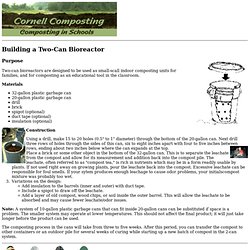

50 Things Everyone Should Know. By Mark and Angel Self-reliance is a vital key to living a healthy, productive life.

To be self-reliant one must master a basic set of skills, more or less making them a jack of all trades. Contrary to what you may have learned in school, a jack of all trades is far more equipped to deal with life than a specialized master of only one. While not totally comprehensive , here is a list of 50 things everyone should know how to do. 1. 2. 3. 4. 5. Can 1 miracle plant solve the world's 3 greatest problems? If someone were to tell you that they had a technology — a weed actually — that could sequester huge amounts of carbon permanently while lifting villagers out of poverty by providing both protein-rich food and super-insulated building materials, you might start to wonder if they were, well, smoking a different weed.

But it appears that one retired building contractor, Bill Loftus, has actually come upon a brilliant application of the fast-growing, carbon-sucking plant known as Kenaf. Kenaf is in the Hibiscus family and is thus related to both cotton and okra. Originally from Africa, this 4,000-year-old crop was used for its fiber. It has the astonishing ability to grow up to 14 feet in one growing season, yielding 6-10 tons of fiber per acre and making it a great source of pulp for paper. But researchers have also discovered (PDF) a corresponding ability of Kenaf to inhale huge quantities of our most abundant global warming gas — CO2. Growing Herbs - How To Grow Herbs. Building a Two-Can Bioreactor. Purpose Two-can bioreactors are designed to be used as small-scall indoor composting units for families, and for composting as an educational tool in the classroom.

Materials 32-gallon plastic garbage can 20-gallon plastic garbage can drill brick spigot (optional) duct tape (optional) insulation (optional) Construction Using a drill, make 15 to 20 holes (0.5" to 1" diameter) through the bottom of the 20-gallon can. Note: A system of 10-gallon plastic garbage cans that can fit inside 20-gallon cans can be substituted if space is a problem. The composting process in the cans will take from three to five weeks. Credits. The $1 garden by Jonathan Nunan Issue #122. The dollar garden is simple in concept: buy as many seeds as you can for one dollar and harvest as much food as possible from the plants you grow.

You see, sometime last year my mother, Susan, read something somewhere that claimed a tomato cost some incredible amount to grow on your own. Mom—whose plan to build a house out of firewood worked out just fine—made it her mission to grow as much as she could on as small a budget possible. Mom currently resides on a nice piece of central Pennsylvania acreage which allows her to plant large amounts of just about anything; she remembers all too well, however, the days when she lived in town ("when I got my water from the city and my eggs from the grocery store").
To make her results easily duplicated by anyone with a small to moderate amount of yard space, she limited our growing area to a six by ten foot plot. Starting the seeds We lucked out when it came to seeds. Preparing the soil Soil preparation began well before warm weather hit. Harvesting. Build a PVC Greenhouse. How to build a PVC greenhouse to extend growing seasons.

Free plans and projects out of PVC pipe. DIY green house to raise or grow plants at home. PVC Greenhouse Built by Michael Arnold. Grow plants from your groceries, like ginger root and pineapple! 5 Secrets to a ‘No-work’ Garden. It took over 20 years of gardening to realize that I didn’t have to work so hard to achieve a fruitful harvest.

As the limitless energy of my youth gradually gave way to the physical realities of mid-life, the slow accretion of experience eventually led to an awareness that less work can result in greater crop yields. Inspired in part by Masanobu Fukuoka’s book, One Straw Revolution, my family experimented with gardening methods which could increase yields with less effort. Fukuoka spent over three decades perfecting his so-called “do-nothing” technique: commonsense, sustainable practices that all but eliminate the use of pesticides, fertilizer, tillage, and perhaps most significantly, wasteful effort. Here are the strategies we used which enabled us to greatly increase our garden yield, while requiring less time and less work. 1.
With ‘no-till’ gardening, weeding is largely eliminated. 2. Gardeners are always on the lookout for free sources of clean organic mulch to add to their garden.